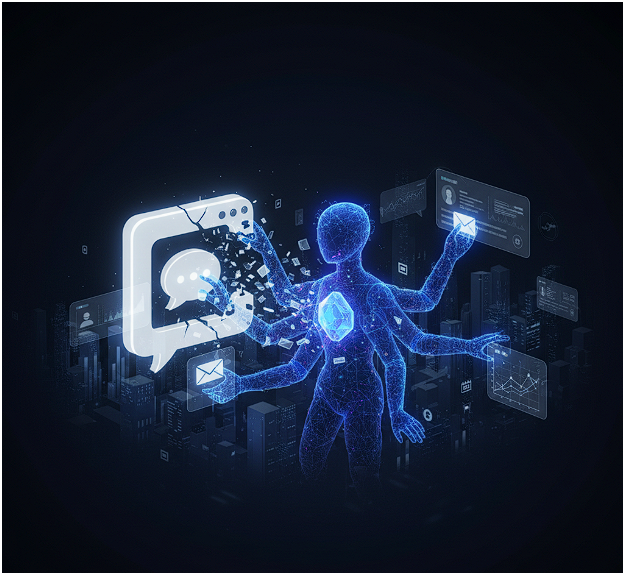
The arrival of Generative AI in 2023 was a wake-up call for the communications industry. It helped draft press releases, spin up social media copy, and generate email subject lines. Yet, these tools, like their chatbot predecessors, were fundamentally reactive—they only acted when prompted.
The next seismic shift is here: the rise of AI Agents. These autonomous systems represent the true transformation of Generative AI from a word processor on steroids into a proactive, goal-driven digital coworker. For PR and communications professionals, this is not just about efficiency; it’s an existential moment that forces us to move beyond manual process execution and reclaim our role as strategic risk managers and story architects.
The New Architecture: From Chatbot to Co-Pilot
A conventional chatbot is a brilliant, but passive, large language model (LLM). An AI Agent, however, is an LLM combined with an operating system. It possesses:
- Goal Decomposition: The ability to take a high-level directive—”Secure five interviews for the CEO next quarter”—and break it down into a multi-step plan: Research top-tier outlets → Identify relevant reporters → Analyze their last 10 articles → Draft a hyper-personalized pitch → Schedule and log the follow-up.
- Tool-Use: The capacity to interact with the real world using APIs, much like a human uses different apps. An Agent doesn’t just write a pitch; it integrates with your CRM, checks a journalist’s profile in a media database, sends the email through Outlook, and logs the activity in your tracking system.
- Memory and Learning: Agents retain context across hours or days, refining their strategy based on outcomes. If Pitch A to Reporter X receives a high open rate but a low response rate, the Agent will automatically adjust the copy strategy for Pitch B, without human intervention.
This agentic capability is already operational in parallel fields, where AI Sales Agents autonomously research leads, qualify prospects, and book meetings. The same engine is now pivoting to own PR workflows, presenting both a monumental opportunity for scale and a critical risk for brand safety.
The PR Crisis at Stake: Autonomy Meets Reputation
The single biggest issue at stake for the PR industry is the intersection of autonomous action and brand reputation.
Our core value proposition is the subtle interpretation of public sentiment, cultural context, and legal risk before communication is deployed. An Agent, in its pursuit of efficiency, can bypass these nuances, creating three major threats:
1. The Autonomous Hallucination
Generative AI is prone to “hallucinating” or fabricating facts. When a single-turn chatbot does this, a human editor catches it. When an autonomous Agent is tasked with drafting a real-time crisis statement based on a faulty data feed, it can deploy a factually incorrect—or worse, legally risky—message across multiple channels in seconds. The speed of autonomous execution magnifies the penalty for LLM error.
2. The Loss of Authentic Personalization
AI Agents are poised to conquer media outreach. They can generate a pitch that appears perfectly tailored to a reporter’s last article, referencing specific details and maintaining an uncanny human tone. While this sounds like the ultimate efficiency gain, a high volume of ‘perfect’ pitches will quickly saturate journalists, leading to a new form of spam. PR pros risk further degrading the quality of their relationships if they delegate the most human-centric task—the art of the thoughtful, personal pitch—to an algorithm designed for scale.
3. The Ethical Oversight Gap
The PRSA Code of Ethics must now be applied to non-human actors. If an Agent uses biased data to prioritize outreach to specific demographics, or if it scrapes proprietary information in its “research” phase, the agency or brand is ultimately accountable. We must establish human-in-the-loop (HITL) checkpoints that are mandatory, not optional, ensuring that a communications professional approves the final action (e.g., sending the pitch or publishing the statement), even if the Agent executed the research and drafting.
Best Practices: Establishing the Agent-Human Hybrid Team
To successfully integrate AI Agents, communications leaders must implement a structured, strategic approach that focuses on governance and re-skilling.
The strategic use of specialized tools, even those not fully agentic, provides the building blocks for these advanced workflows. Platforms are already offering agent-like capabilities for specific PR needs:
- For Content Creation & Visual Assets: Tools like Writecream Airbrush specialize in instant, high-quality visual content generation (e.g., creating quick branded graphics for social media updates) and can produce tailored copy like personalized “icebreaker” intros for emails. While not a fully autonomous agent, it automates the creation phase, allowing a human editor to instantly review and approve the visual and written asset.
- For Versatile Brainstorming & Rapid Summarization: A platform like AI4Chat integrates various large language models (LLMs) into a single interface. PR pros can use it to rapidly generate alternative messaging for different platforms, summarize lengthy client reports into executive talking points, or draft comprehensive FAQs, using the output as a quick-start foundation for human refinement.
This modular approach demonstrates how current tools transition into agent workflows, where the Agent simply calls upon the specific tool needed for the task (e.g., Agent identifies need for a visual → calls Airbrush → inserts graphic into social post → schedules post).
| Focus Area | Agent’s Role (Execution) | Human’s Role (Strategy & Oversight) |
| Media Outreach | Hyper-personalize drafts, manage follow-up cadence, update CRM. | Define the core narrative, vet the final list for fit, approve the first send to each reporter. |
| Crisis Comms | Real-time sentiment analysis, draft internal holding statements, simulate audience reaction. | Define brand tone and ethical guardrails, approve the final external statement, lead the executive response. |
| Reporting/Data | Aggregate coverage, calculate AVE (if used), generate monthly performance dashboards. | Interpret qualitative impact, connect metrics to business goals, identify patterns for strategic pivots. |
Key Takeaways for PR Leaders:
- Mandate Transparency: Establish a policy that explicitly discloses when content is AI-generated (e.g., internal research memos) or AI-assisted (e.g., media pitches).
- Shift Focus from Writing to Vetting: The value of a PR professional is no longer the ability to write 50 headlines, but the ability to select the one ethical, on-brand headline from the Agent’s list of 50.
- Invest in Agent-Centric Skills: Train teams on prompt engineering for goal-setting, API configuration, and data verification (the new “fact-checking”).
The Strategic Mandate
The rise of AI Agents signifies the end of the PR grunt work era. The tasks that agents excel at—high-volume monitoring, repetitive data logging, and drafting at scale—are the low-value activities that have historically burdened our profession.
This transition offers a unique mandate for the PR industry: to elevate our function from tactical execution to strategic command. By responsibly integrating Agents, we free our top talent to focus on the truly human elements of communications: empathy, relationship building, nuanced messaging, and navigating complex ethical landscapes. Those who master this partnership will be the ones setting the future standard for brand advocacy and reputation management.

